Below are some pictures of the undercarriage of a 1998 ford crown
victoria police interceptor. When these pictures were taken, the
vehicle in question was around 11 years old.
Here's the front of the car. Here you can see the suspension control
arms, oil pan, steering linkage, and oil cooler.
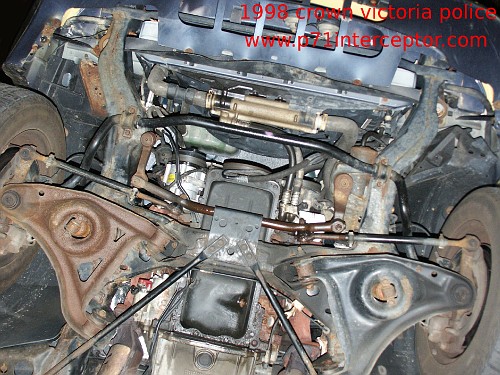
Here's a closeup of the oil cooler system
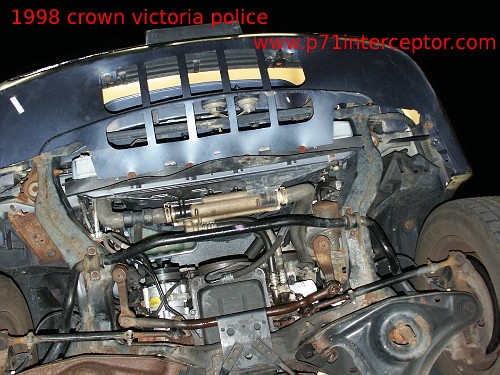
A few years back , the front suspension on this car was overhauled. The
control arm on the right is a ford dealer service assembly for a 1998
crownvic. The one on
the right was from a salvaged ~2 year old 20k mile 2002 crown
victoria. Sometime in the 1999 model year, ford stopped painting the
control arms and the difference in corrosion is quite visible between
the two.

Here's a closeup of the bottom of the transmission

And the catalytic converters
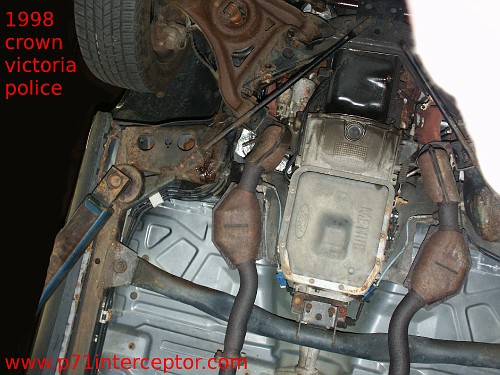
Here's the rear axle assembly and fuel tank. This rear suspension setup
is called a "Watt's
Linkage". 1998 was the first model year for this particular rear
suspension setup in the crownvic. And 1997 and prior cars will look
somewhat different in the rear.
Also note that at some point, the axle
appears to have been overfilled with oil resulting in significant
overflow out the differential vent tube. Interestingly, this oil is not
visible when the car is sitting on the ground under normal ambient
lighting.
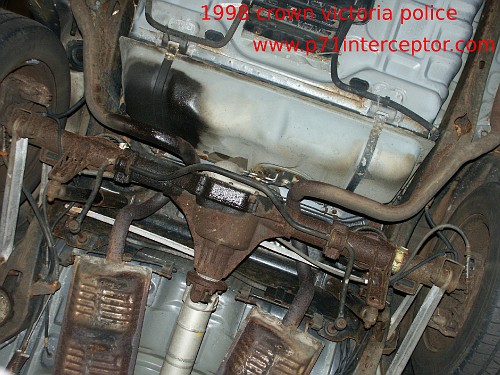
Here's a closeup of the bracket which holds the tranny cooler lines to
the engine block. Also visible is part of the starter motor and a the
frame where the lower control arm mounts.
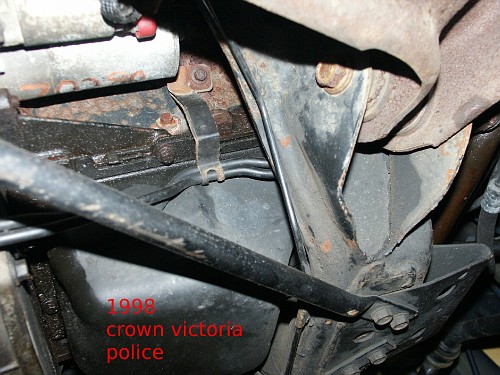
Here's are the tranny cooler lines from a different angle. Part of the
oil pan, transmission and starter are also visible.

A closeup of the new ~2 month old visteon a/c compressor. Notice how
all of the black factory paint is still present on the clutch assembly.
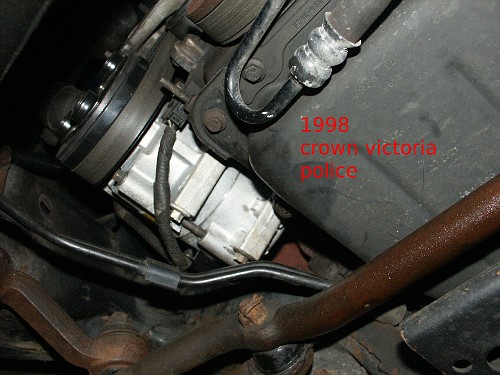
Here's the trunk floor. For 10 year old 100k+ mile police cruiser in
this area of the country, the trunk floor is in good condition. Do note
that the majority of the car owning general public will never see this
part of their car under these particular lighting conditions.
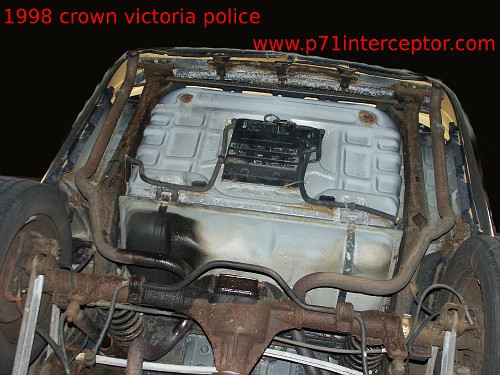
The black box in the middle of the trunk floor contains the evaporative
emissions charcoal canister and related valves. All 1998+ crownvics
should have this part. But in rural police departments, you'll
sometimes find this item ripped clean off the floor from offroading
adventures. Note that 1997 & prior vehicles have the charcoal
canister located in an alternate location and the floorpan in the back
won't have this part attached to it.
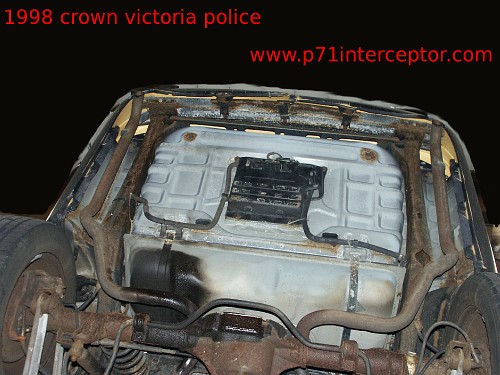

Most 100k+ mile police cruisers will have a little oil seepage
in between the engine oil pan and the engine block near where the
transmission meets the engine. As long as the oil doesn't
drip on the ground and you don't run your car out of oil, this doesn't
usually cause any problems.
Do pay attention to any leaks coming from the transmission bellhousing
though. If the transmission front pump->torque converter seal is
leaking, you might want to shy away from purchasing the car at auction.
Once one tranny seal starts to fail, others are often not far behind
including the clutchpack lipseals.
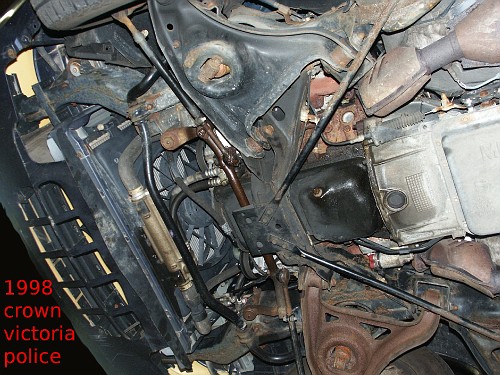
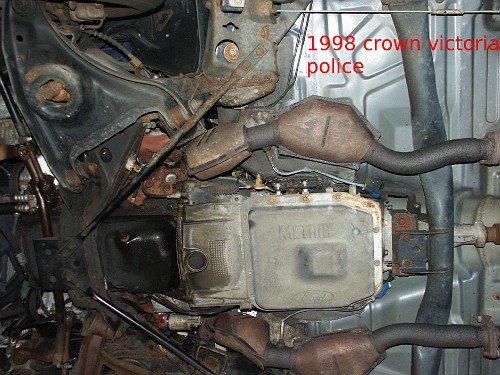
Many of the early 1992-1997 aero-body crownvics will have a cosmetic
plastic cover that extends from the radiator core support to the engine
crossmember. This part blocks access to numerous suspension and engine
components. For people that like to tinker with their cars, you can
remove this plastic cover and retain the bumper cover to the core
support with some nylon cable ties without any ill effects.
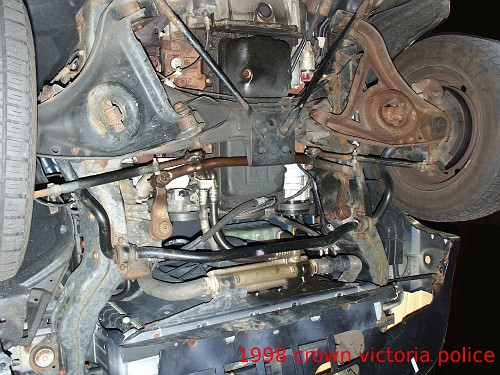
Notice how protected the engine oil pan is in relation to the 2003+
crownvics. Engine damage from a mangled oil pan in the pre-2003 cars is
relatively rare even in severe duty police use.
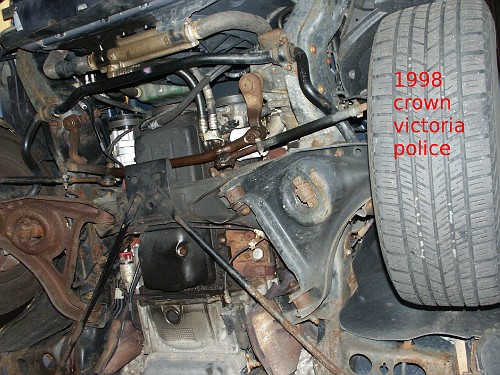
From the factory, these cars used "lubed-for-life" suspension
components that do not have an grease fittings. But all of the
suspension joints on this car have been replaced with aftermarket
components that are greaseable.
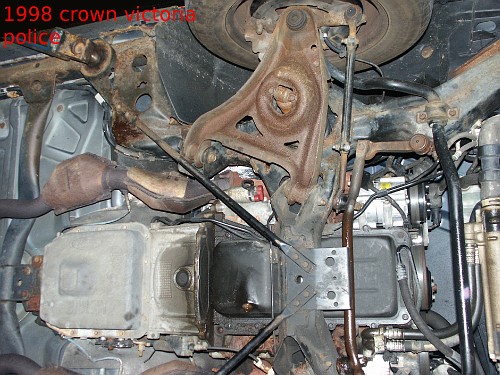
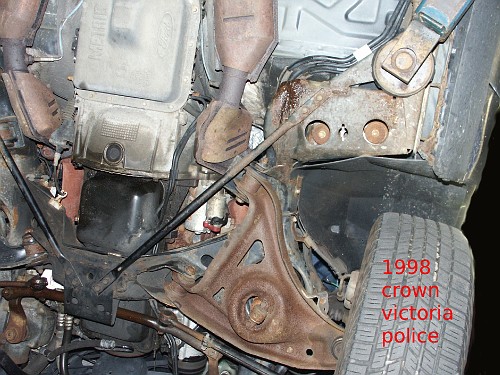

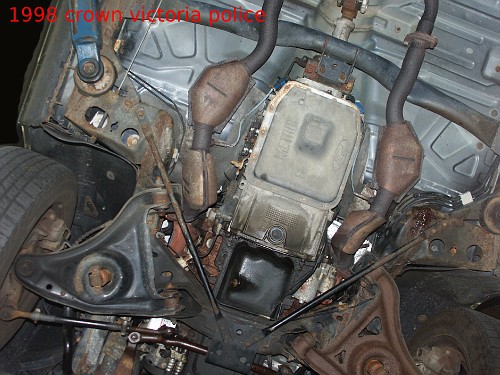
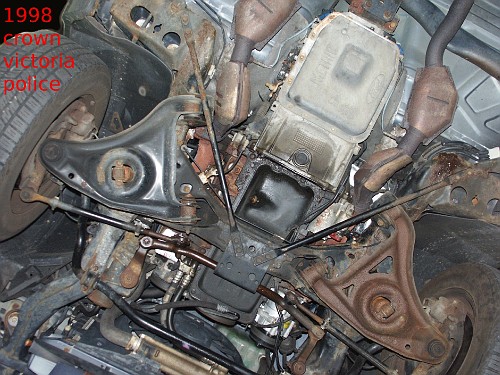
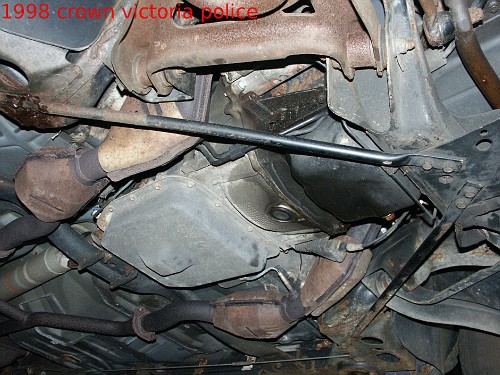
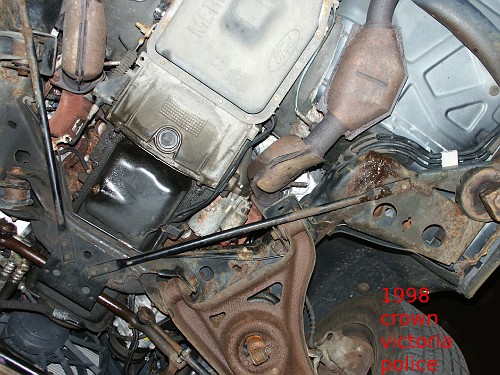



This car had a ford remanufactured transmission installed several years
ago. The remanufactured transmissions from your local ford dealership
are coated with a gloss grey paint. Most of the paint on the bottom of
the transmission has worn away, but it's still present on the top and
sides of the tranny.


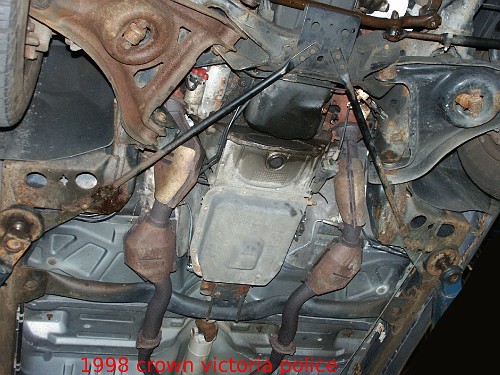
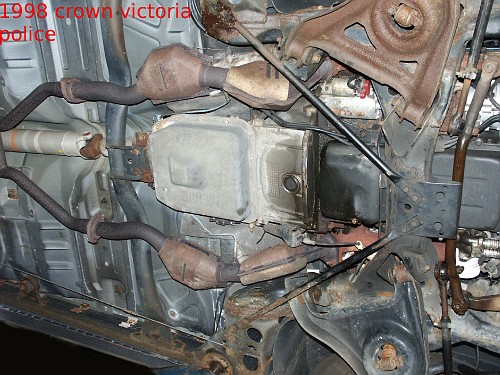
Lets take a look at the emergency brake system
Here's the front portion of the e-brake cable where it comes through
the firewall and passes through the frame
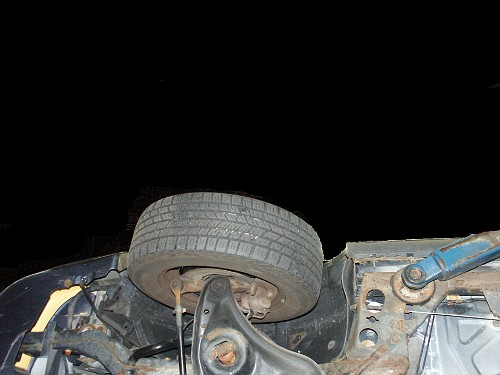

Here's how the e-brake cable passes through the firewall into the frame
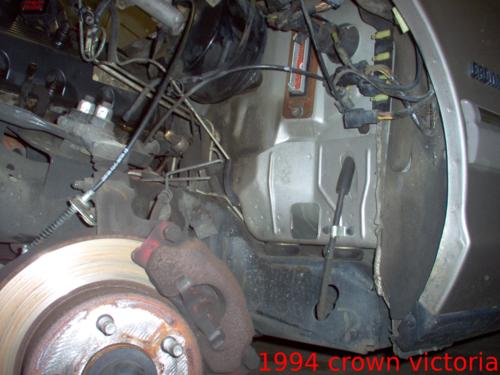
Here's how the e-brake cable passes by the transmission crossmember
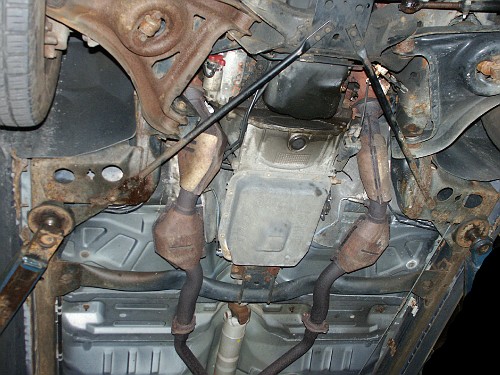
Here's the e-brake cable floorpan insulator and the adjustment mechanism
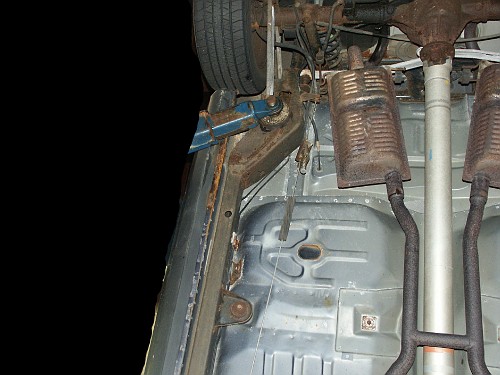
A closeup of the ebrake cable adjuster and floorpan insulator

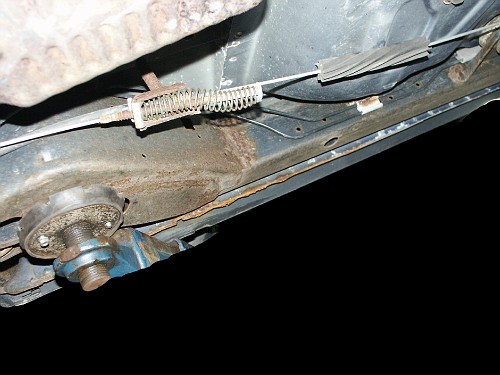
The electrical cable passing through the floor near the adjuster is for
one of the rear axle wheel speed sensors for the antilock brake system.
If you remove the rear seat in your crownvic, you can see the other
side of this cable.

Here's how the e-brake cable passes over the rear axle

A closeup of how the e-brake cable is attached to the shock absorber
tower and maneuvers around the swaybar

The e-brake shoe backing plate
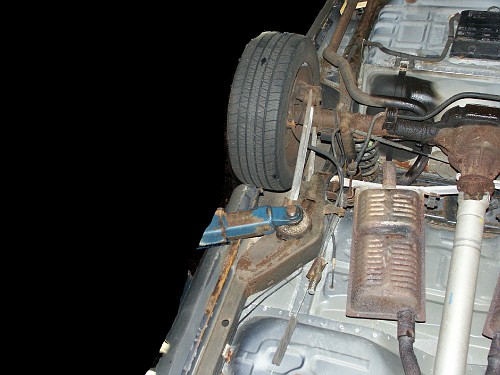
The other side of the car
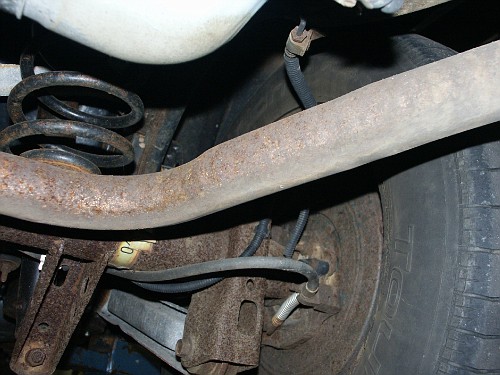
Here's the fuel filter. All 1998+ crownvics use the same mounting
location, however the earlier aerobody crownvics had the fuel filter on
the opposite side of the car.
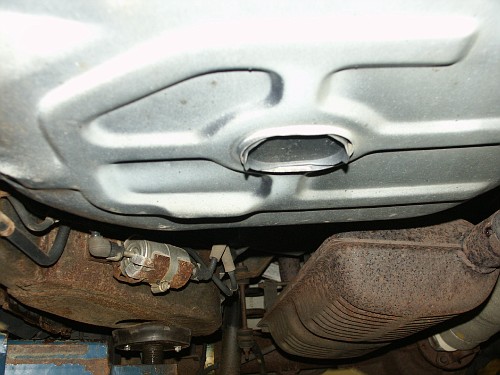
To remove the fuel line connections, springlock tools are required. In
theory, you simply slide the spring lock release tool into the garter
springs and the fitting releases. But this often doesn't happen in the
salt belt states due to corrosion and a salt crust layer locking parts
together. And yes, stainless steel
does corrode, it just "stains less" than a steel without a high
chromium content.

Here's a closeup of the muffler. The two small circular holes are to
drain water out of the muffler. These holes are factory installed and
are supposed to be there.
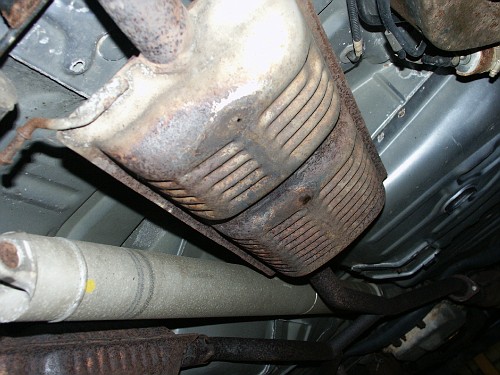
Here's the bottom of the floorpan where the front two seats mount.
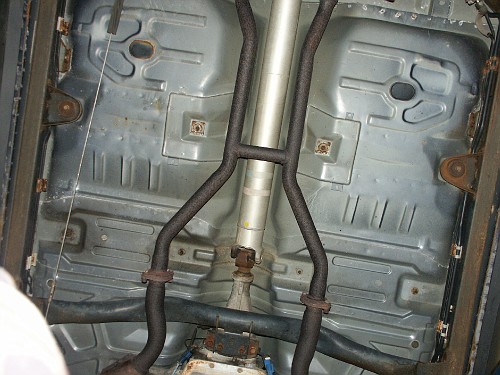
A closeup of the big washers that the front seat bolts mount into.
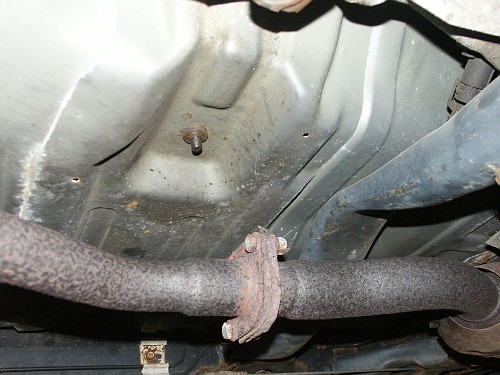
On some cars, you'll need to hold these stationary with a pair of
pliers to stop them from spinning when you remove the bolts above. In
other cars, you'll find these big washers are missing and have been
replaced with some generic washers/nuts from the local hardware store.

Here's a closeup of the crash bracket that the seat belt latch attaches
to
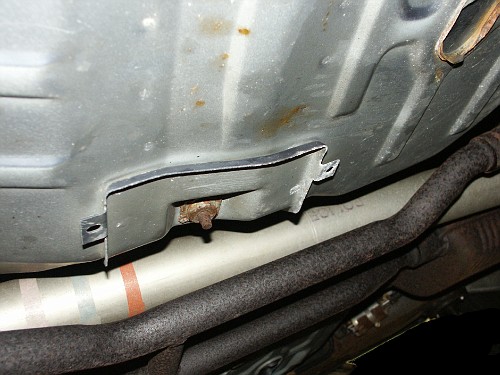
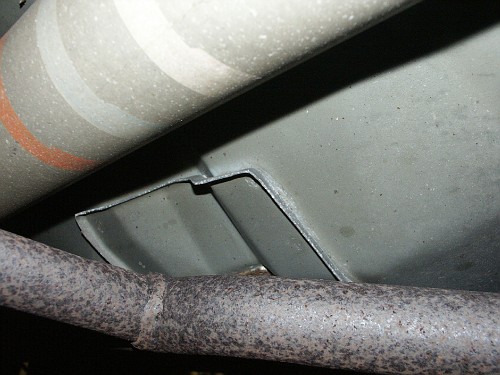
Here's the rear axle assembly vent tube. This tube allows excess fluid
pressure to vent to the atmosphere but keeps water from getting in.
This part has a
habit of going missing to parts unknown. If you need one of these
molded hose assemblies for your crownvic, the part # is F5AZ-4023-AA.
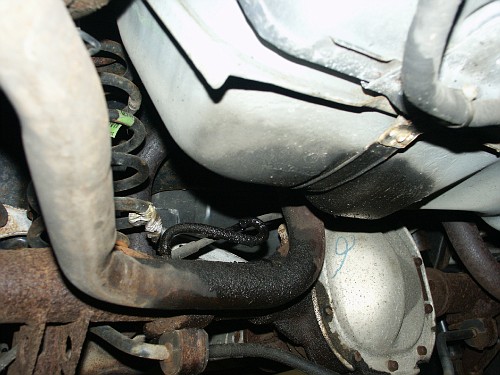
Here are some pictures of the rear sway bar setup


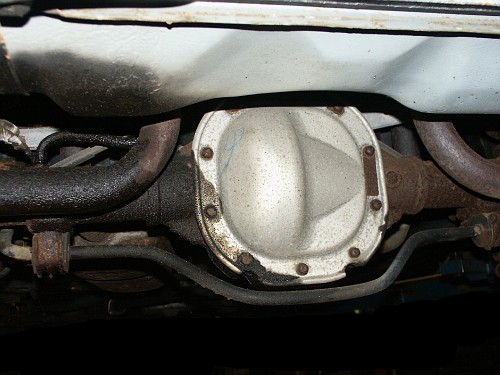
The rear sway bar links in these cars are solid metal not a hollow tube
with a bolt passing through like you'll often find in other vehicles

Here's the top of the swaybar link where it passes through the
vehicle's frame


Do note that the routing of the evaporative emissions canister hoses
changed a little bit in later model years. Here's a picture of a 2000
crownvic trunk floor next to a 1998 one.


Notes:
-These pictures were taken with crown victoria internet discussion
forums in mind. It's sometimes really difficult to describe an issue
without good pictures of the parts in question. And taking good
pictures of undercar parts can be really difficult for the a
casual shadetree mechanic. For these pictures, tools were used that
many backyard mechanics don't have including: a high-end DSLR
camera, a commercial 2 post shop lift,
and
lots
of
overhead
lighting.
-There are some additional pictures of this car with all four
tires/wheels removed avaliable by clicking here.
-This car has a factory installed blue paint job complete with blue
colored undercar body panels. On cars that have been repainted a
different color, you'll find that the color of the trunk, doors, hood,
etc does not match the color of the body panels underneath your car.
This is convienent if you're shopping for a pre-owned crownvic and are
wondering if it's ever been repainted.
-The blue color of the undercar body panels really shows the road salt
deposits. On a white car, road salt deposits would be much more
difficult to see.
-There has been some talk about corrosion. This is a really complex
topic that you can find numerous engineering books written about. But
in an oversimplified sense, there are a few different corrosion
enviroments scattered around the united states.
--The "Rust Belt Car". The winter in these areas gets cold and lots of
rock
salt and sand are used to clear snow/ice from the roadways. The salt
greatly
accelerates the rate at which exposed metal corrodes. Lots of abrasive
debris is present during the winter from airborne ice particles and
sand. The summers in these areas are often rather humid too.
--The "Southern State Car". The winter in these areas is relatively
mild.
Road salt is not used, but the roads are sanded in some locations. Cars
in these states will get light surface rust but nothing like the heavy
scaly rust that you'll get in the salt belt. The summers in these areas
are sometimes longer and more humid than the rust belt states.
--The "Desert Car". For corrosion to take place, water is required. In
an dry arid enviroment like phoenix arizona, metal parts are unable to
rust
due to lack of water. Plastic and rubber parts often have a rather
short life in such an enviroment. Air conditioning system parts often
don't fare much better in these high heat enviroments either.
As you can see, much of the factory installed rust preventative
coatings have worn away on this car. This is typical of a car 10+ year
old car in the northeast. This is not a show car, so the main concern
with undercar part corrosion is lost functionality. For example:
Perforated brake lines or oil pans that leak fluid through holes that
aren't supposed to be there. A suspension control arm that doesn't
attach to the frame anymore because the control arm box rotted off.
etc...
Some toyota tacoma and 4runner truck owners have commented that the
rear differential axle assembly looks rusty on this car and could "rot
through" sometime soon which would cause fluid leaks. Unlike toyota
vehicles, ford uses really thick metal on the differential. So even if
a lot of metal is lost because of thick scaly rust, you've still got a
really thick peice of metal left behind to seal fluid in and bear the
rear suspension loads. On older ford vehicles, you'll sometimes
encounter rusted out spring perches or rear differential covers, but
having the axle tubes or carrier pumpkin of the axle assembly develop
rust pinholes that oil can leak out through is
unheard of (even in the salt belt states). Attempting to lower vehicle
weight and save money on production costs by purchasing less steel to
build an axle assembly was not one of toyota's better ideas.


























































